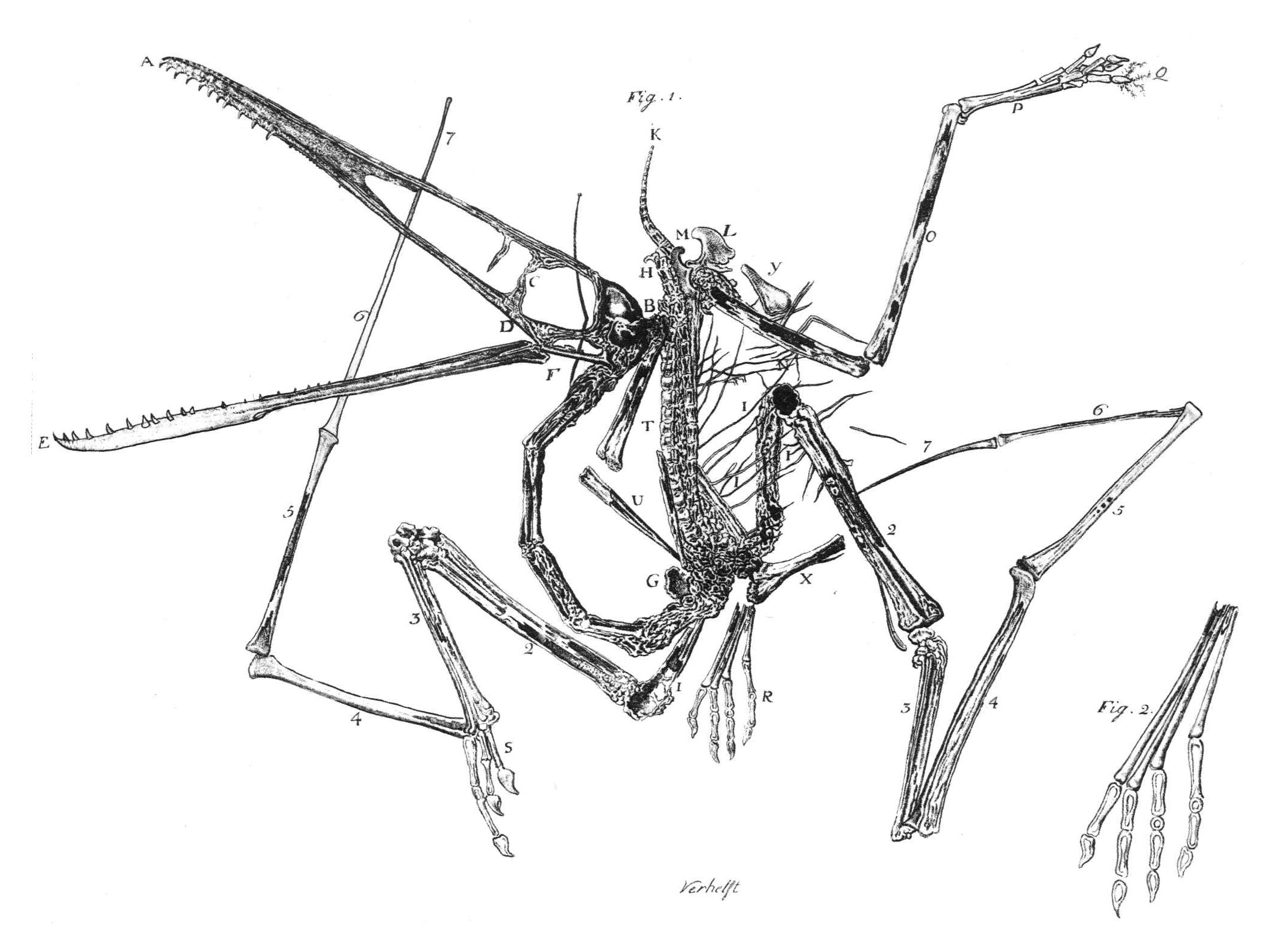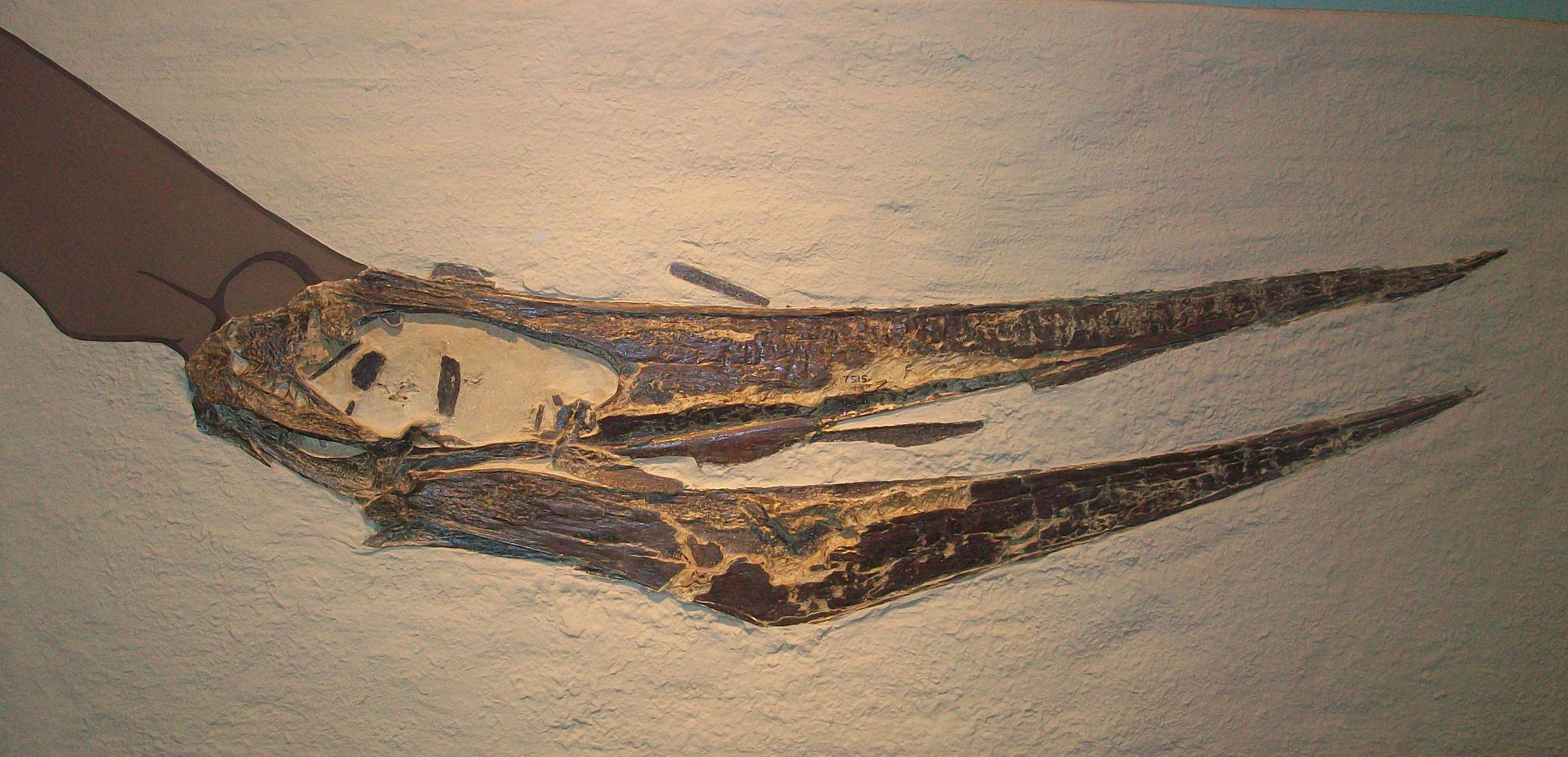|
Ornithocheirus
''Ornithocheirus'' (from Ancient Greek "ὄρνις", meaning ''bird'', and "χεῖρ", meaning ''hand'') is a pterosaur genus known from fragmentary fossil remains uncovered from sediments in the UK and possibly Morocco. Several species have been referred to the genus, most of which are now considered as dubious species, or members of different genera, and the genus is now often considered to include only the type species, ''Ornithocheirus simus''. Species have been referred to ''Ornithocheirus'' from the mid-Cretaceous period of both Europe and South America, but ''O. simus'' is known only from the UK, though a specimen referred to ''O.'' cf. ''simus'' is also known from Morocco. Because ''O. simus'' was originally named based on poorly preserved fossil material, the genus ''Ornithocheirus'' has suffered enduring problems of zoological nomenclature. Fossil remains of ''Ornithocheirus'' have been recovered mainly from the Cambridge Greensand of England, dating to the beginni ... [...More Info...] [...Related Items...] OR: [Wikipedia] [Google] [Baidu] |
Ornithocheirus MANCH L10832
''Ornithocheirus'' (from Ancient Greek "ὄρνις", meaning ''bird'', and "χεῖρ", meaning ''hand'') is a pterosaur genus known from fragmentary fossil remains uncovered from sediments in the UK and possibly Morocco. Several species have been referred to the genus, most of which are now considered as dubious species, or members of different genera, and the genus is now often considered to include only the type species, ''Ornithocheirus simus''. Species have been referred to ''Ornithocheirus'' from the mid-Cretaceous period of both Europe and South America, but ''O. simus'' is known only from the UK, though a specimen referred to ''O.'' cf. ''simus'' is also known from Morocco. Because ''O. simus'' was originally named based on poorly preserved fossil material, the genus ''Ornithocheirus'' has suffered enduring problems of zoological nomenclature. Fossil remains of ''Ornithocheirus'' have been recovered mainly from the Cambridge Greensand of England, dating to the beginni ... [...More Info...] [...Related Items...] OR: [Wikipedia] [Google] [Baidu] |
Ornithocheirus
''Ornithocheirus'' (from Ancient Greek "ὄρνις", meaning ''bird'', and "χεῖρ", meaning ''hand'') is a pterosaur genus known from fragmentary fossil remains uncovered from sediments in the UK and possibly Morocco. Several species have been referred to the genus, most of which are now considered as dubious species, or members of different genera, and the genus is now often considered to include only the type species, ''Ornithocheirus simus''. Species have been referred to ''Ornithocheirus'' from the mid-Cretaceous period of both Europe and South America, but ''O. simus'' is known only from the UK, though a specimen referred to ''O.'' cf. ''simus'' is also known from Morocco. Because ''O. simus'' was originally named based on poorly preserved fossil material, the genus ''Ornithocheirus'' has suffered enduring problems of zoological nomenclature. Fossil remains of ''Ornithocheirus'' have been recovered mainly from the Cambridge Greensand of England, dating to the beginni ... [...More Info...] [...Related Items...] OR: [Wikipedia] [Google] [Baidu] |
Ornithocheirus Clifti
''Ornithocheirus'' (from Ancient Greek "ὄρνις", meaning ''bird'', and "χεῖρ", meaning ''hand'') is a pterosaur genus known from fragmentary fossil remains uncovered from sediments in the UK and possibly Morocco. Several species have been referred to the genus, most of which are now considered as dubious species, or members of different genera, and the genus is now often considered to include only the type species, ''Ornithocheirus simus''. Species have been referred to ''Ornithocheirus'' from the mid-Cretaceous period of both Europe and South America, but ''O. simus'' is known only from the UK, though a specimen referred to ''O.'' cf. ''simus'' is also known from Morocco. Because ''O. simus'' was originally named based on poorly preserved fossil material, the genus ''Ornithocheirus'' has suffered enduring problems of zoological nomenclature. Fossil remains of ''Ornithocheirus'' have been recovered mainly from the Cambridge Greensand of England, dating to the beginni ... [...More Info...] [...Related Items...] OR: [Wikipedia] [Google] [Baidu] |
Tropeognathus
''Tropeognathus'' (meaning "keel jaw") is a genus of large pterosaurs from the late Early Cretaceous of South America. This genus is considered to be a member of the family Anhangueridae, however, several studies have also recovered it within another family called Ornithocheiridae. Both of these families are diverse groups of pterosaurs known for their keel-tipped snouts and large size. ''Tropeognathus'' is regarded as the largest pterosaur found in the Southern Hemisphere, only rivaled by the huge azhdarchids. The type and only species is ''Tropeognathus mesembrinus''. Fossil remains of ''Tropeognathus'' have been recovered from the Romualdo Formation, which is a Lagerstätte located in the Santana Group of the Araripe Basin in northeastern Brazil. Discovery and naming In the 1980s the German paleontology museum '' Bayerische Staatssammlung für Paläontologie und historische Geologie'' in Munich acquired a pterosaur skull from Brazilian fossil dealers that had probably bee ... [...More Info...] [...Related Items...] OR: [Wikipedia] [Google] [Baidu] |
Lonchodectes
''Lonchodectes'' (meaning "lance biter") was a genus of lonchodectid pterosaur from several formations dating to the Turonian (Late Cretaceous) of England, mostly in the area around Kent. The species belonging to it had been assigned to ''Ornithocheirus'' until David Unwin's work of the 1990s and 2000s.Kellner, A.W.A. (2003). Pterosaur phylogeny and comments on the evolutionary history of the group: In: Buffetaut, E., and Mazin, J.-M. (Eds.). ''Evolution and Palaeobiology of Pterosaurs''. Geological Society Special Publication 217:105-137. 1-86239-143-2. Several potential species are known; most are based on scrappy remains, and have gone through several other generic assignments. The genus is part of the complex taxonomy issues surrounding Early Cretaceous pterosaurs from Brazil and England, such as ''Amblydectes'', ''Anhanguera'', ''Coloborhynchus'', and ''Ornithocheirus''. History and species Numerous species have been referred to this genus over time, and only those more ... [...More Info...] [...Related Items...] OR: [Wikipedia] [Google] [Baidu] |
Coloborhynchus
''Coloborhynchus'' is a genus of pterodactyloid pterosaur belonging to the family Anhangueridae, though it has also been recovered as a member of the Ornithocheiridae in some studies. ''Coloborhynchus'' is known from the Lower Cretaceous of England (Valanginian age, 140 to 136 million years ago), and depending on which species are included, possibly the Albian and Cenomanian ages (113 to 93.9 million years ago) as well. ''Coloborhynchus'' was once thought to be the largest known toothed pterosaur, however, a specimen of the closely related ''Tropeognathus'' is now thought to have had a larger wingspan. History and classification Like many ornithocheiroid pterosaurs named during the 19th century, ''Coloborhynchus'' has a highly convoluted history of classification. Over the years numerous species have been assigned to it, and often, species have been shuffled between ''Coloborhynchus'' and related genera by various researchers. In 1874 Richard Owen, rejecting the creation by H ... [...More Info...] [...Related Items...] OR: [Wikipedia] [Google] [Baidu] |
Pterodactylus
''Pterodactylus'' (from Greek () meaning 'winged finger') is an extinct genus of pterosaurs. It is thought to contain only a single species, ''Pterodactylus antiquus'', which was the first pterosaur to be named and identified as a flying reptile. Fossil remains of ''Pterodactylus'' have primarily been found in the Solnhofen limestone of Bavaria, Germany, which dates from the Late Jurassic period (early Tithonian stage), about 150.8 to 148.5 million years ago. More fragmentary remains of ''Pterodactylus'' have tentatively been identified from elsewhere in Europe and in Africa. ''Pterodactylus'' was a generalist carnivore that probably fed on a variety of invertebrates and vertebrates. Like all pterosaurs, ''Pterodactylus'' had wings formed by a skin and muscle membrane stretching from its elongated fourth finger to its hind limbs. It was supported internally by collagen fibres and externally by keratinous ridges. ''Pterodactylus'' was a small pterosaur compared to other famo ... [...More Info...] [...Related Items...] OR: [Wikipedia] [Google] [Baidu] |
Cambridge Greensand
The Cambridge Greensand is a geological unit in England whose strata are earliest Cenomanian in age. It lies above the erosive contact between the Gault Formation and the Chalk Group in the vicinity of Cambridgeshire, and technically forms the lowest member bed of the West Melbury Marly Chalk Formation.Cambridge Greensand at BGS It is a remanié deposit, containing reworked fossils of late age, including those of dinosaurs and pterosaurs. Description The lithology is made out of |
Pteranodon
''Pteranodon'' (); from Ancient Greek (''pteron'', "wing") and (''anodon'', "toothless") is a genus of pterosaur that included some of the largest known flying reptiles, with ''P. longiceps'' having a wingspan of . They lived during the late Cretaceous geological period of North America in present-day Kansas, Nebraska, Wyoming, South Dakota and Alabama. More fossil specimens of ''Pteranodon'' have been found than any other pterosaur, with about 1,200 specimens known to science, many of them well preserved with nearly complete skulls and articulated skeletons. It was an important part of the animal community in the Western Interior Seaway. ''Pteranodon'' was not a dinosaur. By definition, all dinosaurs belong to the group Dinosauria; ''Pteranodon'' belongs to the group Pterosauria. Nonetheless, ''Pteranodon'' is the most famous pterosaur, frequently featured in dinosaur media and strongly associated with dinosaurs by the general public. While not dinosaurs, pterosaurs such as ' ... [...More Info...] [...Related Items...] OR: [Wikipedia] [Google] [Baidu] |
Ornithocheirus Buenzeli
"''Ornithocheirus''" ''buenzeli'' (often mis-spelled ''O. bunzeli''Averianov, A.O. (2010).The osteology of ''Azhdarcho lancicollis'' Nessov, 1984 (Pterosauria, Azhdarchidae) from the Late Cretaceous of Uzbekistan" ''Proceedings of the Zoological Institute of the Russian Academy of Sciences'', 314(3): 246-317.) is a pterosaur species known from parts of a humerus (upper arm bone) and part of a lower jaw found in late Cretaceous period (Campanian stage) rocks of the Grünbach Formation, Austria. While it has traditionally been classified in the genus ''Ornithocheirus'', it is more likely an azhdarchid, though due to the fragmentary nature of known fossil remains, it is considered a ''nomen dubium In binomial nomenclature, a ''nomen dubium'' (Latin for "doubtful name", plural ''nomina dubia'') is a scientific name that is of unknown or doubtful application. Zoology In case of a ''nomen dubium'' it may be impossible to determine whether a s ...''.Buffetaut, E., Psi, A., and Prondvai ... [...More Info...] [...Related Items...] OR: [Wikipedia] [Google] [Baidu] |
Junior Synonym
The Botanical and Zoological Codes of nomenclature treat the concept of synonymy differently. * In botanical nomenclature, a synonym is a scientific name that applies to a taxon that (now) goes by a different scientific name. For example, Linnaeus was the first to give a scientific name (under the currently used system of scientific nomenclature) to the Norway spruce, which he called ''Pinus abies''. This name is no longer in use, so it is now a synonym of the current scientific name, ''Picea abies''. * In zoology, moving a species from one genus to another results in a different binomen, but the name is considered an alternative combination rather than a synonym. The concept of synonymy in zoology is reserved for two names at the same rank that refers to a taxon at that rank - for example, the name ''Papilio prorsa'' Linnaeus, 1758 is a junior synonym of ''Papilio levana'' Linnaeus, 1758, being names for different seasonal forms of the species now referred to as ''Araschnia lev ... [...More Info...] [...Related Items...] OR: [Wikipedia] [Google] [Baidu] |
Pterosaur
Pterosaurs (; from Greek ''pteron'' and ''sauros'', meaning "wing lizard") is an extinct clade of flying reptiles in the order, Pterosauria. They existed during most of the Mesozoic: from the Late Triassic to the end of the Cretaceous (228 to 66 million years ago). Pterosaurs are the earliest vertebrates known to have evolved powered flight. Their wings were formed by a membrane of skin, muscle, and other tissues stretching from the ankles to a dramatically lengthened fourth finger. There were two major types of pterosaurs. Basal pterosaurs (also called 'non-pterodactyloid pterosaurs' or 'rhamphorhynchoids') were smaller animals with fully toothed jaws and, typically, long tails. Their wide wing membranes probably included and connected the hind legs. On the ground, they would have had an awkward sprawling posture, but the anatomy of their joints and strong claws would have made them effective climbers, and some may have even lived in trees. Basal pterosaurs were insectiv ... [...More Info...] [...Related Items...] OR: [Wikipedia] [Google] [Baidu] |









